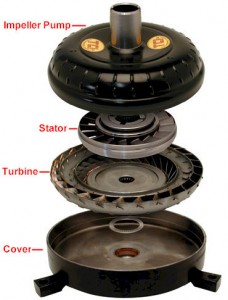You may be reading this article because you suspect that something is amiss with the automatic transmission in your car. Often times, people experience what they feel may be a transmission concern but are unsure. Take my advice; it is far better to address these problems early on than to let them evolve into a catastrophic transmission failure.
Because the automatic transmission is the most complex piece of machinery in your entire vehicle, no way a list of warning signs be all-inclusive. With that said, here are the 7 most common warning signs that have been observed by transmission repair specialists over the years. These are the early warning signs that you want to look out for:
1) Fluid Leakage. That small pool of pinkish oil that you see when you move your vehicle from its parking spot in the morning is a sign of trouble. Transmissions can leak from nearly 20 different external seals- some are very simple to repair, while others require more involved service procedures. In any case, the idea is to have the vehicle looked at right away by a qualified transmission repair shop because, much like an engine that gets low on oil, a transmission that is low on fluid can fail completely in very short order.
2) Washboard feeling at 45 to 60 mph. Sometimes a shaking or bucking sensation is experienced, especially at highway speeds. While this may be an issue of poor engine tune, it could also be a malfunction in the torque converter. Take it to an expert that can tell the difference and diagnose it for you.
3) Delayed drive or reverse. A noticeably longer than normal hesitation for your transmission to engage a gear once the shifter is put in “D” or “R” is another sign of a transmission malfunction. These delays can be caused by anything from a low fluid level or a band that is in need of adjustment to an internal transmission seal or clutch pack that is failing. Again, sooner rather than later is the right time to get it checked out. A neutral like condition on a brisk acceleration from a stop or when going around a turn. This is a clear sign of a low fluid condition. Remember, unlike an engine where it may be normal for some oil to be consumed over time, if a transmission is low on fluid it is leaking.
4) Burning odors. A burnt odor can be a sign of a transmission that is overheating or is leaking fluid onto the exhaust. This needs to be addressed immediately- if engine oil or transmission fluid drips onto a hot rods exhaust it could catch on fire.
5) Check engine light. Today’s transmissions are computer controlled and a check engine light can be an indication of a trans problem, even if you don’t have a drivability symptom yet. Modern automobile computers are extremely sensitive and can detect a transmission slip or malfunction that would be imperceptible to the driver. The light comes on to tell you that something is wrong somewhere- pay heed to it and get your car diagnosed now!
6) Transmission Slipping. Slipping is a condition where the engine is revving but full power is not getting to the wheels. Slipping can be caused by a variety of transmission malfunctions- all of which should be checked ASAP.
7) Rough shifting and wrong gear starts. A hard shift or wrong gear start either by itself or in conjunction with a check engine light may be a sign that your transmission is in a computer commanded “limp in” mode. This can be triggered by your vehicle’s computer when it detects a transmission fault. The reason for this computer strategy is to let the driver know that there is a problem and to help protect the transmission from further damage while it has “limped” to a shop to be diagnosed.
While we often fall into the trap of hoping that problems with our vehicles will somehow go away or fix themselves, rarely does it work out that way. Paying attention to and addressing your vehicle’s small problems before they turn into larger ones can often help you to avoid costly transmission repairs or one of our transmissions.
GotTransmissions.com @ 866-320-1182



